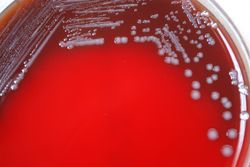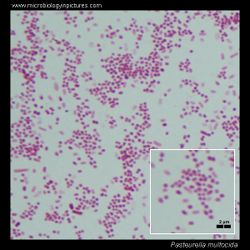Pasteurella caballi
Classification
Phylum: Proteobacteria
Class: Gammaproteobacteria
Order: Pasteurellales
Genus: Pasteurella
Species: Pasteurella caballi
|
NCBI: Taxonomy |

Description and significance
Pasteurella caballi, from Latin, caballinus ("horse") is a group of bacterial strains which were first isolated from the respiratory systems of horses. L. K. Schlater and his associates, working from the university of Iowa and the USDA, first isolated 29 different strains of the organism in 1989. They proposed that the collection of strains be placed in the genus Pasturella due to several shared traits, such as DNA relatedness and cellular fatty acids.(1) All of the currently reported P. caballi strains are gram-negative, oxidase-positive, nonmotile, fermentative rods.(1,2) P. caballi differs from other Pasteurella species in that all are aerogenic and catalase negative.(1) For laboratory observation and culture, it has been noted that colonies of P. caballi are non-acid-fast and bipolar stained. In addition, observable colonies are 1.0-1.5mm in diameter, non-hemolytic, smooth, slightly raised, and grayish-yellow after 24 hours of incubation. Colonies grow at room temperature and at 37°, but not at 4°.(3)

Genome and genetics
a. To what major branch of the prokaryotes do they belong? (see textbook or Bergey’s). List 2-3 closely related but separate species or genera of bacteria. b. Briefly describe any extra-chromosomal elements or genetic tools that are used to study the bacterium: viruses, plasmids, transposons that allow genetic manipulation and analysis. c. Has the genome or genomes been sequenced? If so, include the website for the database and one or two highlights of the genome. Also indicate genome size (base pairs), %G+C (nucleotide base composition) and number of genes, and specific genes or gene regions that are unique to this organism. If it has not been sequenced, give its closest relative that has been sequenced, its website, and some general information about the related sequence.
Example: The sequence of Haemophilus influenzae was determined using whole genome shotgun sequencing (Fleischmann et al. 1995).
Nutrition and metabolism
a.Describe the growth characteristics of your bacterial species; sources of C, N, electrons; respires/ferments, uses O2, etc. b.What kinds of culture conditions (temp, pH, media) are needed for laboratory study? c.What kinds of waste, by-products, volatile compounds are generated?
Ecology / Pathology
Ecology: How is your microorganism important in the ecosystem where it is found? How does it impact other organisms in the environment (could be positive or negative impact)? Pathology: How does the microbe cause disease as it interacts with the host? Describe any specific toxins or pathways that are used for invading and causing disease in the host. What treatment is used to inhibit or kill the microbe?
Current Research
Describe recent research and findings that have been done with this organism. The research can be clinical, applied or basic research. This section should be based on 2 recent papers (10 years or less) and summarized in your own words. References
The format for citations and for the “References” list will follow the “Citation—Name” Council of Science Editors (CSE) format, as the suggested formatting method listed on the MicrobeWiki Home page. The reference list will be numbered based on an alphabetical list of the first author’s last name. A style guide for the CSE format can be found here: http://writing.wisc.edu/Handbook/DocCSE_CitationSystems.html.
For an example, see this entry: https://microbewiki.kenyon.edu/index.php/Bacillus_anthracis
References
(1) Schlater, Linda Kelley, et al. "Pasteurella caballi, a new species from equine clinical specimens." Journal of clinical microbiology 27.10 (1989): 2169-2174.
(2) Blackall, P. J., M. Bisgaard, and R. A. McKenzie. "Characterisation of Australian isolates of Actinobacillus capsulatus, Actinobacillus equuli, Pasteurella caballi and Bisgaard Taxa 9 and 11." Australian veterinary journal 75.1 (1997): 52-55.
Authored by Joshua Place, a student of CJ Funk at John Brown University
